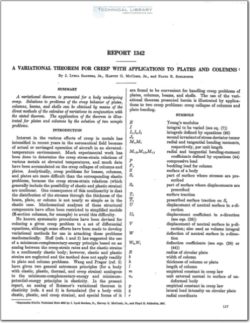NACA-Report-1342

- Version
- 174 Downloads
- 710.77 KB File Size
- 1 File Count
- December 4, 2015 Create Date
- December 4, 2015 Last Updated
National Advisory Committee for Aeronautics, Report - A Variational Theorem for Creep with Applications to Plates and Columns

A variational theorem is presented for a body undergoing
creep. Solutions to problems of the creep behavior of plates,
columns, beams, and shells can be obtained by means of the
direct methods of the calculus of variations in conjunction with
the stated theorem. The application of the theorem is illus-
trated for plates and columns by the solution of two sample
problems.
Interest in the various efiects of creep in metals has
intensified in recent years in the aeronautical field because
of actual or envisaged operation of aircraft in an elevated—
temperature environment. Much experimental work has
been done to determine the creep stress-strain relations of
various metals at elevated temperatures, and much data
have been accumulated on the creep collapse of columns and
plates. Analytically, creep problems for beams, columns,
and plates are more difficult than the corresponding elastic
problems, because the creep stress-strain relations (which
generally include the possibility of elastic and plastic strains)
are nonlinear. One consequence of this nonlinearity is that
the distribution of the stresses through the thickness of the
beam, plate, or column is not nearly so simple as in the
elastic case. Mathematical analyses of these structural
components have often been restricted to simplified models
(II-section columns, for example) to avoid this difficulty.
No known systematic procedures have been devised for
reducing a given creep problem to a set of differential
equations, although some efforts have been made to develop
variational methods for use in attacln'ng these problems
mathematically. Hofi (refs. 1 and 2) has suggested the use
of a minimum-complementary—energy principle based on an
analog between the creep-strain rates and the elastic strains
in a nonlinearly elastic body; however, elastic and plastic
strains are neglected and the method does not apply readily
to plate and column problems. Wang and Prager (ref. 3)
have given two general extremum principles (for a body
with elastic, plastic, thermal, and creep strains) analogous
to the minimum-complementary-energy and minimum-
potential-energy principles in elasticity.
| File | Action |
|---|---|
| naca-report-1342.pdf | Download |

Comment On This Post